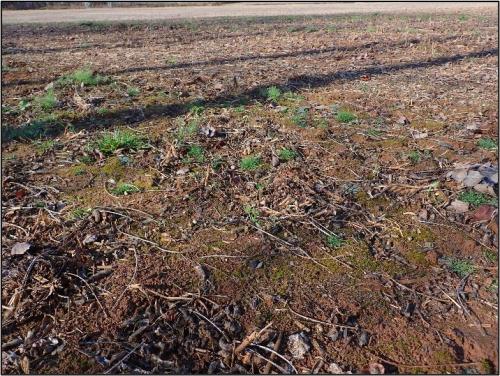Soil crusts – a source of biodiversity and contributor to soil function
By Sean R. Haughian, Curator of Botany at the Nova Scotia Museum
An important early step in soil development is the growth of a biological soil crust – a mixture of microflora (mosses, lichens, algae, bacteria) and microfauna (nematodes, insects, mites, protists) that grow as a thin veneer over the surface. These soil crusts have been shown to contribute a lot of ecosystem services. For example, soil crusts can enhance soil carbon and nitrogen content, increase topsoil stability, and improve water retention in deserts, tundra, and disturbed habitats. The role of these soil crusts on farms is not as well understood, but researchers at the Nova Scotia Museum have discovered exceptional species diversity in these habitats over the last several years, including finding at least 8 species of mosses, liverworts, or hornworts that were not previously known from the province.
To find out more about the role of these soil crusts on Nova Scotian farms, I am collaborating with the Nova Scotia Federation of Agriculture and the Clean Annapolis River Project to study biodiversity of non-crop species near field edges on Nova Scotian farms. Our work is a small part of the nation-wide Living Labs initiative, sponsored by Agriculture Canada and Environment Canada. To find out more about the many projects covered by this initiative, you can visit the project website here.
So far, my students and I have sampled in four different farms with corn & soybean fields between Windsor and Berwick. Our main goal is to answer two questions:
- Does the cover or diversity of soil crusts correlate with soil properties, such as carbon content, bulk density, or texture?
- How do field size, configuration, tillage practices, and the composition of adjacent habitats impact the soil crust?
To answer these questions, we (myself, my student assistant, NSM Research Associate Tom Neily, and a few volunteers) collect data in the following ways:
- Visual surveys of soil crusts on fields during the non-growing season
- Extract soil samples (15 × 7 cm cores) to analyze texture and carbon content
- Conduct germination trials for soil crust species from soil samples
Once done, some possible benefits of the work are:
- Developing rapid assessment methods for soil carbon, texture classes, or other soil properties based on soil crust features
- Improved understanding of the ecological benefits of farms for soil crust diversity, of the benefits of soil crusts for farm soils, and of the ecology of soil crust species
Have you seen any interesting plants while visiting farms lately? Or do you know of any farmers who might be interested in participating? Reach out to me at the museum to chat more about this interesting project, or the unique diversity of soil crust species on Nova Scotian farms.

A moss known as Physcomitrium immersum thrives at the shady edges of farm fields.

A rich mixture of mosses, liverworts, and cyanobacteria graces this little patch of soil at the edge of a soybean field.

Hornworts, like this Phaeoceros caroliniana, are considered rare in many jurisdictions because they are limited to receding banks of naturally flowing rivers. In Nova Scotian farms, they seem to like field margins where tractors have created small ruts. Hornworts contain small pockets that are filled with nitrogen-fixing cyanobacteria and could significantly benefit soil fertility.

Moss-dominated soil crusts seem to thrive best near the edges of fields, where the shadows of nearby trees provide respite from the intense sun in late summer.